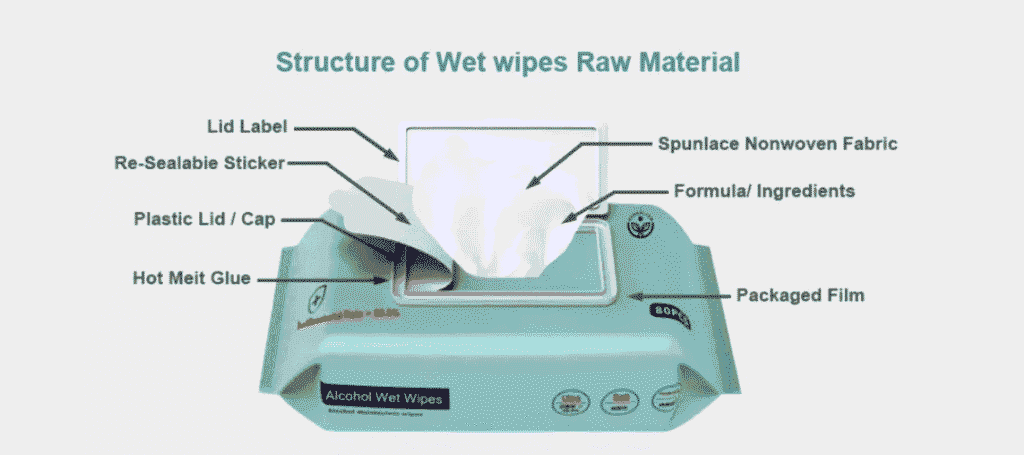
When you open a pack of wet wipes, everything looks so neat and ready to use. But have you ever wondered what materials go into making them? Wet wipes are not just about the fabric — they involve a combination of different raw materials that work together to ensure convenience, hygiene, and durability. Let’s break it down in a simple way.
1. Spunlace Nonwoven Fabric:
This is the heart of the wet wipe — the fabric you actually use.
Spunlace nonwoven fabric is a soft, strong, breathable, moisture-absorbent, and pill-resistant superior material, making it suitable for use in medical and industrial fields. For example, it is used in applications such as baby wipes, makeup removal wipes and disinfectant wipes.
- Function: Soft, absorbent, and gentle on skin.
- Material: Made by entangling fibers with high-pressure water jets, without using weaving or knitting. Common fibers include viscose, polyester, or cotton blends.
2. Formula Components(Liquid):
It provides cleaning, moisturizing, or disinfecting effects.The liquid content in wet wipes generally accounts for about 80%. If the content is too low, the wipes will feel dry; if it’s too high, they will feel too wet and inconvenient to use. Therefore, after testing, a liquid ratio of around 80% is found to be most appropriate. Since over 90% of the liquid is water, to prevent reactions between the water’s components and the liquid’s components, the water used in wet wipes must be specially treated. The terms “purified water,” “pure water,” and “RO pure water” are listed on the ingredient list.
3. Composite Packaging Foil Roll Film:
This is the “outer skin” of the wet wipes pack.
- Function: Protects the wipes, prevents leakage, and makes the pack easy to carry.
- Material: Usually plastic film Composed of two or three materials such as OPP, BOPP, CPP, PET/PE , VMPET (ALU+PET), etc., compounded together. It that can be printed with colorful branding and product details.
4. Stickers:
Some smaller packs of wipes don’t use a hard plastic lid. Instead, they have a resealable sticker label.
- Material: Made from flexible film with special adhesive that doesn’t lose stickiness after multiple uses.
- Function: Works like a cover that sticks and reseals to keep the moisture inside.
Self-adhesive tabs for multi-use wet wipes that can be opened and closed, with good sealing properties to prevent moisture loss.
5. Plastic Lid:
That little flip-top plastic lid on your wet wipes pack is more important than it looks.
- Material: Usually made from durable plastic that can be opened and closed many times.
- Function: It keeps the wipes moist and prevents them from drying out.
6. Lid Labels:
Display brand and product information.
7. Hot Melt Adhesive(Glue):
You might not see this part, but it’s there!
- Material: A safe adhesive that works well on plastic surfaces and can withstand moisture.Used to attach the lids of wet wipe bags, securing the plastic covers and preventing them from falling off.
- Function: Used to attach the plastic lid or fix labels securely to the packaging film.
Wet wipes are the result of combining fabric, liquid, and smart packaging. From the soft spunlace nonwoven fabric to the protective plastic lid and packaging film, every piece plays an important role in making wet wipes safe, hygienic, and convenient for everyday use.
So next time you open a pack, you’ll know exactly what’s inside — not just the wipes, but the hidden teamwork of different materials that keep them fresh and ready to use.
